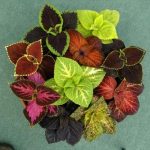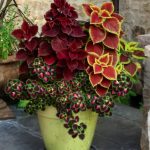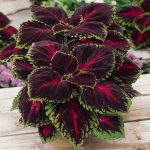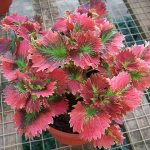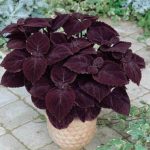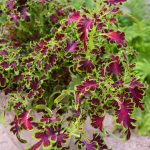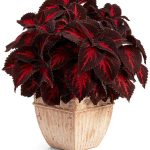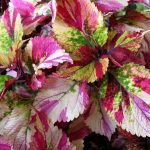| Common Name | Coleus |
| Botanical Name | Plectranthus scutellarioides |
| Family | Lamiaceae |
| Plant Type | Herbaceous perennial (usually grown as an annual) |
| Mature Size | 6-36 in. tall and wide |
| Sun Exposure | Part shade to full shade |
| Soil Type | Rich, moist, loose soil, well-drained |
| Soil pH | Slightly acidic to neutral (6.0 to 7.0) |
| Bloom Time | Seasonal |
| Flower Color | Blue to white |
| Hardiness Zones | 10-11 (USDA); grown as an annual everywhere |
| Native Area | Asia |
| Toxicity | Toxic to animals |
Warmer zones can grow coleus as garden perennials, where they can grow to resemble small shrubs with thick woody stems. Though this tender tropical plant loves the heat, it grows as an annual in just about any garden, where it’s normally used as an annual bedding plant or in containers. However, not all coleus plants are frost-tolerant, Wait until temperatures remain reliably above 60 degrees Fahrenheit before you move them out into the garden.
Light
Though coleus prefers part-shade or full-shade to sun, its light exposure depends on the variety. The old-fashioned seed-grown coleus does best in part shade to full shade, but newer cultivars, like the Wizard series, perform well in full sun. Too much sun can scorch leaves and cause the color to fade in most classic coleus varieties. Coleus performs best with filtered morning sun and shade in the afternoon, especially in hot climates.
Plants grown in containers indoors usually get plenty of light from indirect sun during the warmer (brighter) months but may need to be exposed to filtered sunlight during the winter. It doesn’t take much, but they do need some light.
Soil
Coleus prefers consistently moist, rich, loose, well-draining soil. Before planting, amend the soil with compost or another organic material, such as perlite. For potted plants, any good-quality potting mix will work fine. Choose a container with drainage holes.
Container-grown coleus loves loose potting soil. Start with a quality mix with a slightly acidic to neutral pH of 6.0 to 7.0. Provide drainage in the pot to ensure the soil isn’t constantly wet, which can lead to root rot.
Water
Coleus plants grow best in soil that is consistently moist but not soggy. Long dry spells slow the plants’ growth, and the leaves will start to turn brown around the edges. Let the soil dry out a bit between waterings and water when the top inch of soil feels dry to the touch. Mulch helps the soil retain moisture longer, but don’t use cedar mulch, which can be toxic to coleus. Also, don’t let the mulch touch the stems, as it can promote rot and hide slugs.
Coleus in containers may need watering twice a day during hot weather. Outdoor containers may require water twice a day. Indoor plants need water only when the top inch of soil feels dry to the touch.
Temperature and Humidity
Coleus thrives in hot, humid conditions. In temperate climates, the barest hint of frost will kill the plants. Move plants indoors or protect them on chilly nights when temperatures dip into the 50s. Take cuttings for propagation before the weather turns cold.
Keep indoor plants away from air conditioner vents and other cold spots. In dry climates, the plants will like some humidity from a humidifier or in the bathroom. Wait until the temperature is 70 degrees Fahrenheit or warmer before taking potted plants outdoors in the spring.
Fertilizer
If you have rich soil, you may not need to feed coleus plants. If you have poor soil, add a balanced slow-release fertilizer to the bed. You’ll get the best color from your coleus leaves if you go easy on the fertilizer.
Feed container-grown plants once a month with a water-soluble fertilizer. Container plants generally need more feeding than garden plants because frequent watering washes nutrients from the potting soil.
Types of Coleus
There are hundreds of coleus plant varieties available with various colors, leaf textures, and patterns. Additional cultivars are developed each year, and garden centers tend to focus on a select popular few. Shop several different places to find more unique varieties. Some types to look for include:
Wizard series: These are small 12- to 14-inch plants in standard color mixes and can be easy to grow from seeds.
Kong series: These coleus varieties have huge 6-inch leaves on big 2-foot tall plants and are sensitive to direct sunlight.
‘Black Dragon’: This unusual variety has deep burgundy leaves with ruffled edges and grows to 18 inches tall.
Premium Sun series: These cultivars are bred to tolerate full sun.
Fairway series: These dwarf coleus varieties grow only 6 to 10 inches tall in a variety of leaf patterns and colors.
Pruning
For full, bushy plants, pinch out the growing tips when the plants are about 6 inches tall. Pinch under the flower buds if you want the plant to spend its energy on leaves and not flowers and seeds.
Plants that are not pruned tend to get leggy and lose their shape and dense foliage. Leggy plants may need more sun. This is most common with indoor plants during winter so give them a bit more sun or, if necessary, artificial light.
Propagating Coleus
Coleus plants can be propagated by taking stem cuttings. Here’s how:
With a sharp, sterile shearing scissor, cut a 4- to 6-inch long stem tip cut right beneath a leaf node along the stem. Remove all leaves from the lower half of the cutting.
Dip the end of the stem in a rooting hormone compound. Plant it in a moist potting mix so the soil covers the exposed leaf nodes.
Place the container in a plastic bag, making sure the plastic doesn’t touch the cutting.
Place the covered cutting in a bright, warm location until new roots develop, which takes two to three weeks.
Remove the plastic and continue growing the new plant in a bright, warm location.
Some of the more unusual cultivars might be reluctant to root, so with these, take plenty of cuttings to ensure that you get enough viable plants.
How to Grow Coleus From Seed
Modern coleus varieties sold in stores are hybrids that are almost always grown from cuttings potted up for nursery sale, but you can still find seeds of many varieties. If you will be planting the coleus in the outdoor garden, start seeds indoors about eight to 10 weeks before your last frost date.
It’s easy to grow coleus from seed. It can take as long as 21 days for the seeds to germinate. Once seedlings appear, it will take three or four weeks of warm weather to help turn them into fully grown plants.
Lightly sprinkle the tiny seeds over a tray filled with potting mix, then lightly cover with a sprinkling of soil.
Cover the tray with plastic and set it in a bright, warm spot until seedlings sprout, which takes about two weeks.
Remove the plastic and continue to grow the seedlings while keeping the soil moist.
When two sets of true leaves appear on the seedlings, carefully transplant them into their own pots and continue growing them until outdoor planting time. Make sure to harden off seedlings before planting them in the garden.
Potting and Repotting Coleus
To grow coleus plants in pots and containers, start with large pots that the plants can grow into, otherwise, you’ll be repotting these fast-growing plants frequently.
In mixed container plantings, coleus usually serves as an upright “thriller” plant in the center of the container, surrounded by “fillers” and “spillers.” In colder zones, move a potted coleus plant indoors to overwinter.
Common Pests & Plant Diseases
Groundhogs and young rabbits love coleus. Protect your plants early in the season to deter pests. Watch for mealybugs, aphids, spider mites, whiteflies, and slugs.
Coleus is not usually bothered by diseases unless the weather turns cool and damp, when you may see signs of fungal diseases such as mildew. The plant enjoys good drainage or standing water can lead to fungal root rot and stem rot.







